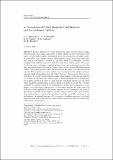Files in this item
A comparison of global magnetic field skeletons and active-region upflows
Item metadata
| dc.contributor.author | Edwards, S. J. | |
| dc.contributor.author | Parnell, C. E. | |
| dc.contributor.author | Harra, L. K. | |
| dc.contributor.author | Culhane, J. L. | |
| dc.contributor.author | Brooks, D. H. | |
| dc.date.accessioned | 2016-11-25T00:33:57Z | |
| dc.date.available | 2016-11-25T00:33:57Z | |
| dc.date.issued | 2016-01-01 | |
| dc.identifier | 243585576 | |
| dc.identifier | 2eae4be4-de1f-4ef9-92d1-1347d4475484 | |
| dc.identifier | 84952630220 | |
| dc.identifier | 000372878100007 | |
| dc.identifier.citation | Edwards , S J , Parnell , C E , Harra , L K , Culhane , J L & Brooks , D H 2016 , ' A comparison of global magnetic field skeletons and active-region upflows ' , Solar Physics , vol. 291 , no. 1 , pp. 117-142 . https://doi.org/10.1007/s11207-015-0807-8 | en |
| dc.identifier.issn | 0038-0938 | |
| dc.identifier.other | ORCID: /0000-0002-5694-9069/work/73700743 | |
| dc.identifier.uri | https://hdl.handle.net/10023/9875 | |
| dc.description.abstract | Plasma upflows have been detected in active regions using Doppler velocity maps. The origin and nature of these upflows is not well known with many of their characteristics determined from the examination of single events. In particular, some studies suggest these upflows occur along open field lines and, hence, are linked to sources of the solar wind. To investigate the relationship these upflows may have with the solar wind, and to probe what may be driving them, this paper considers seven active regions observed on the solar disc using the Extreme ultraviolet Imaging Spectrometer aboard Hinode between August 2011 and September 2012. Plasma upflows are observed in all these active regions. The locations of these upflows are compared to the global potential magnetic field extrapolated from the Solar Dynamics Observatory, Helioseismic and Magnetic Imager daily synoptic magnetogram taken on the day the upflows were observed. The structure of the magnetic field is determined by constructing its magnetic skeleton in order to help identify open-field regions and also sites where magnetic reconnection at global features is likely to occur. As a further comparison, measurements of the temperature, density and composition of the plasma are taken from regions with active-region upflows. In most cases the locations of the upflows in the active regions do not correspond to areas of open field, as predicted by a global coronal potential-field model, and therefore these upflows are not always sources of the slow solar wind. The locations of the upflows are, in general, intersected by separatrix surfaces associated with null points located high in the corona; these could be important sites of reconnection with global consequences. | |
| dc.format.extent | 26 | |
| dc.format.extent | 50852127 | |
| dc.language.iso | eng | |
| dc.relation.ispartof | Solar Physics | en |
| dc.subject | Magnetic fields, corona | en |
| dc.subject | Solar wind | en |
| dc.subject | Astronomy and Astrophysics | en |
| dc.subject | Space and Planetary Science | en |
| dc.subject | NDAS | en |
| dc.title | A comparison of global magnetic field skeletons and active-region upflows | en |
| dc.type | Journal article | en |
| dc.contributor.sponsor | Science & Technology Facilities Council | en |
| dc.contributor.institution | University of St Andrews. School of Mathematics and Statistics | en |
| dc.contributor.institution | University of St Andrews. Applied Mathematics | en |
| dc.identifier.doi | 10.1007/s11207-015-0807-8 | |
| dc.description.status | Peer reviewed | en |
| dc.date.embargoedUntil | 2016-11-24 | |
| dc.identifier.grantnumber | ST/K000950/1 | en |
This item appears in the following Collection(s)
Items in the St Andrews Research Repository are protected by copyright, with all rights reserved, unless otherwise indicated.

